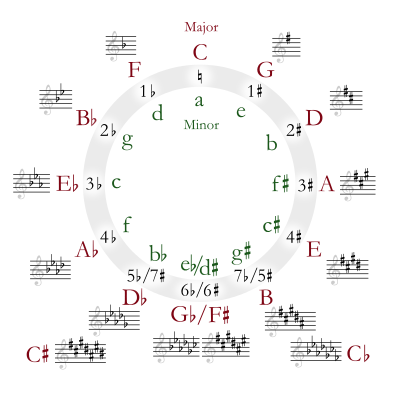A-flat minor
 | |
| Relative key |
C♭ major enharmonic: B major |
|---|---|
| Parallel key | A♭ major |
| Dominant key | E♭ minor |
| Subdominant |
D♭ minor enharmonic: C♯ minor |
| Enharmonic | G♯ minor |
| Component pitches | |
| A♭, B♭, C♭, D♭, E♭, F♭, G♭, A♭ | |
A-flat minor is a minor scale based on A-flat, consisting of the pitches A♭, B♭, C♭, D♭, E♭, F♭, and G♭. For the harmonic minor, the G♭ is raised to G♮. Its key signature has seven flats (see below: Scales and keys).
Its relative major is C♭ major (or, enharmonically, B major), and its parallel major is A♭ major. Its direct enharmonic equivalent is G♯ minor.
Changes needed for the melodic and harmonic versions of the scale are written in with accidentals as necessary.
Although A-flat minor occurs in modulation in works in other keys, it is only rarely used as the principal key of a piece of music. Some well-known uses of the key in classical and romantic piano music include:
- The Funeral March in Ludwig van Beethoven's Piano Sonata No. 12, Op. 26.
- An early section of the last movement of Beethoven's Piano Sonata No. 31, Op. 110 (although the key signature of this section uses only 6 flats, not 7).
- The Adagio of Friedrich Kalkbrenner's Piano Concerto No. 4, Op. 127, although it is written with a four-flat key signature and uses accidentals to indicate the minor mode.
- The first piece "Aime-moi" ("Love me") from Charles-Valentin Alkan's Trois morceaux dans le genre pathétique
- Johannes Brahms's Fugue for organ (c. 1857).
- Max Bruch's Concerto for Two Pianos and Orchestra, Op. 88a (although at least one two-piano transcription of this uses a 6-flat signature, similarly to the Op. 110 Beethoven example).
- The Evocación from Book I of Isaac Albéniz's Iberia.
- Leoš Janáček uses it for his Violin Sonata and the organ solo of his Glagolitic Mass.
- The opening of Igor Stravinsky's The Firebird.
- Moritz Moszkowski used it for his piano etude, Op. 72 No. 13.
- Franz Liszt's original version of "La campanella" from Grandes études de Paganini, which was subsequently rewritten in G-sharp minor.
- In Gustav Mahler's Ninth Symphony, there is a particularly aggressive restatement of the introduction of the third movement in A-flat minor.[1]
It is also used in Frederick Loewe's score to the 1956 musical play My Fair Lady; the Second Servants' Chorus is set in A-flat minor (the preceding and following choruses being a semitone lower and higher respectively).
More often, pieces in a minor mode that have A-flat's pitch as tonic are notated in the enharmonic key, G-sharp minor, because of G-sharp's appreciably simpler key signature and it has just five sharps as opposed to the seven flats of A-flat minor. As a result, only works expressly notated as such may reasonably be considered to be in A-flat minor.
In some scores, the A♭ minor key signature in the bass clef is written with the flat for the F on the second line from the top.[nb 1]
Scales and keys
| Diatonic scales and keys | |||||||||||||||||||||||||||||||||||||||||||||||||||||||
|---|---|---|---|---|---|---|---|---|---|---|---|---|---|---|---|---|---|---|---|---|---|---|---|---|---|---|---|---|---|---|---|---|---|---|---|---|---|---|---|---|---|---|---|---|---|---|---|---|---|---|---|---|---|---|---|
 |
| ||||||||||||||||||||||||||||||||||||||||||||||||||||||
| The table indicates the number of sharps or flats in each scale. Minor scales are written in lower case. | |||||||||||||||||||||||||||||||||||||||||||||||||||||||
Notes
- ↑ An example of this is the bass clef staff of the harp parts in the Jupiter movement of Gustav Holst's orchestral suite The Planets.[2]